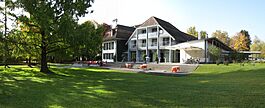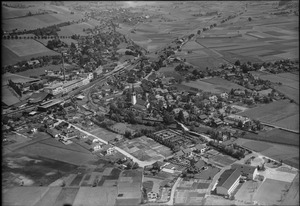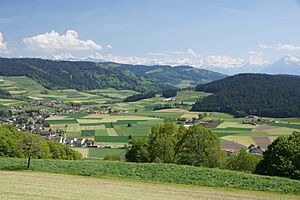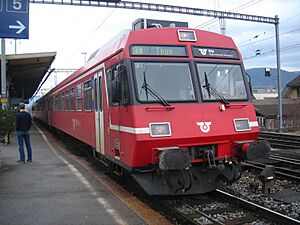Konolfingen facts for kids
Quick facts for kids
Konolfingen
|
||
|---|---|---|
 |
||
|
||
| Country | Switzerland | |
| Canton | Bern | |
| District | Bern-Mittelland | |
| Area | ||
| • Total | 12.77 km2 (4.93 sq mi) | |
| Elevation | 658 m (2,159 ft) | |
| Population
(Dec 2020 )
|
||
| • Total | 5,451 | |
| • Density | 426.86/km2 (1,105.6/sq mi) | |
| Postal code |
3510
|
|
| Surrounded by | Freimettigen, Grosshöchstetten, Häutligen, Mirchel, Münsingen, Niederhünigen, Schlosswil, Tägertschi, Trimstein | |
Konolfingen is a town, also called a municipality, located in the Bern-Mittelland area of the canton of Bern in Switzerland. It's a busy place with a mix of old traditions and new developments.
Contents
Discovering Konolfingen's Past
Konolfingen is first mentioned in old records from 1148. However, the town as we know it today is quite new! It was formed in 1933 when two smaller villages, Gysenstein and Stalden, joined together.
How Konolfingen Grew Over Time
Even though the current town is new, the original Konolfingen village was once an important local center. Powerful families like the Counts of Kyburg and later the city of Bern used it as a main administrative spot. It even had a "high court" where important legal decisions were made.
The town was first owned by the Lords of Krauchtal. Later, around 1397 or 1424, they gave Konolfingen to Thorberg Abbey, which was a religious community. In 1528, Bern changed its official religion to Protestantism. This meant the Abbey's lands, including Konolfingen, became government property.
Konolfingen remained an important administrative center until 1798. After that, another town called Schlosswil took over as the main administrative and court center for the area.
Churches and Community Life
For a long time, Konolfingen was part of the church community of Münsingen. But in 1898, the people of Konolfingen built their own smaller church. By 1911, the villages separated to form their own church community, first called Stalden, then renamed Konolfingen in 1912. A Catholic church was also built in the town in 1967.
The Arrival of Transportation and Industry
Much of the land around Konolfingen used to be too wet for farming. But drainage projects in the mid-1800s and early 1900s made the land usable. This also helped traffic move through the area.
Between 1851 and 1856, the village of Stalden became a key stopping point for travelers. Then, in 1864, a railway station was built between Konolfingen and Stalden. Another railway connection followed in 1899. These easy transport links encouraged businesses, like the Berneralpen dairy, to build factories there. This brought more jobs and helped the villages grow.
Finally, in 1933, the communities of Gysenstein (which included Konolfingen village) and Stalden officially merged to create the municipality of Konolfingen. The new town kept growing, and a secondary school opened in 1949.
Konolfingen's Natural Surroundings
Konolfingen covers an area of about 12.8 square kilometers (about 5 square miles). A large part of this land, about 66.3%, is used for farming. Forests cover about 19.1% of the area. The rest, about 14.5%, is covered by buildings and roads. A tiny bit, 0.1%, is rivers or lakes.
The town is located at an altitude of over 650 meters (about 2,130 feet). Because of its location, Konolfingen is often called the "gateway to the Emmental" region, which is famous for its rolling hills and cheese.
Villages and Hamlets of Konolfingen
When Konolfingen was formed in 1933, it brought together the old villages of Konolfingen-Dorf and Stalden. The municipality also includes several smaller farming hamlets (tiny villages). These include Gysenstein, Herolfingen, Hürnberg, Ursellen, Ballenbüel, and Hötschigen, along with many scattered farmhouses.
In 2010, Konolfingen became part of a new administrative area called Verwaltungskreis Bern-Mittelland.
Konolfingen's Coat of Arms
The blazon (official description) of Konolfingen's coat of arms is: Or a Semi Lion Rampant double-tailed Gules issuant from three bricked Wall Sable and in chief two Mullets of the second.
In simpler terms, the coat of arms shows a red lion with two tails. It looks like the lion is coming out of a black brick wall. Above the lion, there are two red stars. The background color of the shield is gold. This unique symbol represents the town of Konolfingen.
Who Lives in Konolfingen?
Konolfingen has a population of about 5,282 people as of 2018. About 8% of the people living here are foreign nationals, meaning they are from other countries. Over the last ten years (2001–2011), the population has grown slightly.
Languages Spoken
Most people in Konolfingen speak German as their first language (about 92.9%). Other languages spoken include Italian (1.3%) and Albanian (1.0%). A small number of people also speak French or Romansh.
Age Groups and Families
In 2011, children and teenagers (ages 0–19) made up about 19.7% of the population. Adults (ages 20–64) were the largest group at 60.3%, and seniors (over 64) made up 20.1%.
In 2000, about 31.4% of the people living in Konolfingen were born there. Many others were born in the same canton (45.9%) or elsewhere in Switzerland (10.7%). About 8.9% of the population was born outside of Switzerland.
There are many different types of households in Konolfingen. In 2000, about 587 households had only one person, while 138 households had five or more people. Most apartments (92.5%) were lived in all the time.
How Konolfingen's Population Has Changed
The population of Konolfingen has generally grown over the years. In 1850, there were about 1,627 people. By 1900, it had grown to 2,030. The population continued to increase steadily, reaching 3,656 by 1950 and 4,606 by 2000. By 2018, the population was 5,282. This shows that Konolfingen has become a more populated place over time.
Konolfingen's Economy
In 2011, Konolfingen had a low unemployment rate of 1.33%, meaning most people who wanted jobs had them. In 2008, about 2,510 people worked in the town.
What Kinds of Jobs Do People Have?
Jobs in Konolfingen can be divided into three main types:
- Primary Sector: This includes jobs related to natural resources, like farming. About 212 people worked in agriculture in 2008.
- Secondary Sector: These are jobs in manufacturing and construction. About 881 people worked in this sector, with many in factories (68.3%) and construction (31.7%).
- Tertiary Sector: This includes jobs that provide services, like shops, restaurants, healthcare, and education. About 1,417 people worked in this sector. Many worked in sales, transportation, hotels, finance, and as professionals like scientists or teachers.
In 2008, there were 2,061 full-time equivalent jobs in Konolfingen. This means if you add up all the hours worked, it's like having 2,061 full-time workers. About 43.8% of the workforce were women.
Commuting to Work
In 2000, about 1,398 people traveled into Konolfingen for work, while 1,456 residents traveled out of Konolfingen to work in other places. This means slightly more people leave Konolfingen for work than come in. About 24.3% of workers used public transportation, and 43.5% used a private car to get to work.
Religious Life in Konolfingen
Based on a 2000 survey, most people in Konolfingen (74.7%) belonged to the Swiss Reformed Church, which is a Protestant church. About 9.9% were Roman Catholic.
Other religions present in the community included Orthodox Christians (0.63%), other Christian churches (8.53%), and Islamic people (3.02%). There were also small numbers of people who were Buddhist or Hindu. About 3.41% of the population did not belong to any church or were agnostic or atheist.
Learning and Education
In Konolfingen, a good number of people have completed higher education. About 41.3% of the population has finished non-mandatory upper secondary education (like high school), and 11.3% have gone on to even higher education, such as university or a Fachhochschule (a type of professional university).
The School System in Bern
The school system in the Canton of Bern works like this:
- One year of optional Kindergarten.
- Six years of Primary school.
- Three years of mandatory lower Secondary school, where students are grouped by their abilities.
After lower Secondary, students can choose to continue their schooling or start an apprenticeship (on-the-job training).
During the 2010–11 school year, 534 students attended schools in Konolfingen. There were 74 kindergarten students, 275 primary students, and 185 lower secondary students. A small percentage of these students were not Swiss citizens or spoke a different language at home.
In 2000, 139 students came to Konolfingen for school from other towns, while 112 Konolfingen residents went to school outside the municipality.
The Local Library
Konolfingen has its own library, called Bibliothek Konolfingen. In 2008, the library had over 12,900 books and other media. It loaned out more than 43,400 items that year. The library was open 320 days a year, for an average of 13 hours per week.
Getting Around Konolfingen
Konolfingen has two railway stations: Konolfingen and Stalden i.E.. The Konolfingen station is a busy spot because it's where two railway lines meet: the Bern–Lucerne line and the Burgdorf–Thun line. Stalden im Emmental station is just south of Konolfingen on the Burgdorf–Thun line. These stations make it easy for people to travel to and from Konolfingen.
|
See also
 In Spanish: Konolfingen para niños
In Spanish: Konolfingen para niños








